Jackson M.J. Micro and Nanomanufacturing
Подождите немного. Документ загружается.

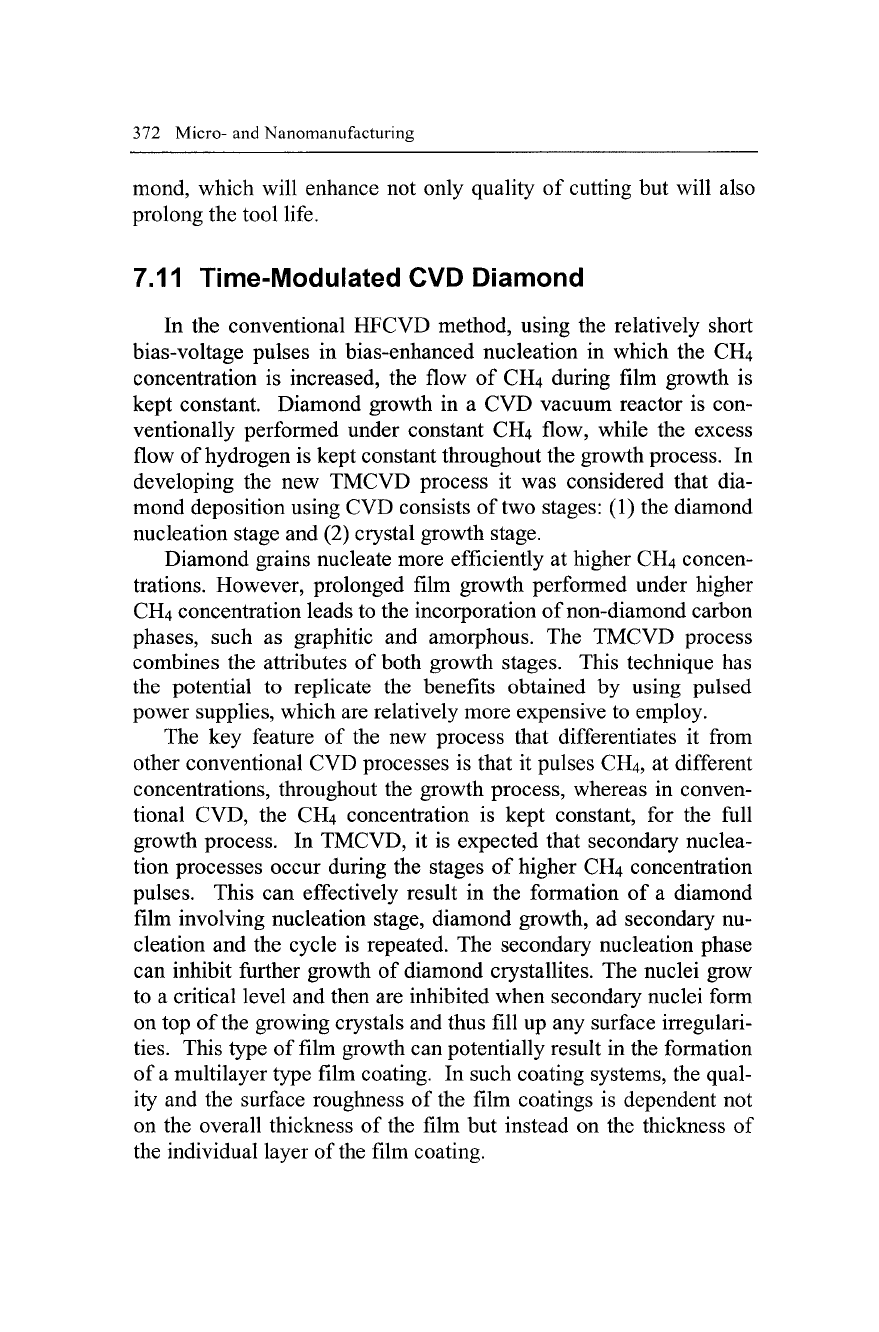
372 Micro- and Nanomanufacturing
mond, which will enhance not only quality of cutting but will also
prolong the tool hfe.
7.11 Time-Modulated CVD Diamond
In the conventional HFCVD method, using the relatively short
bias-voltage pulses in bias-enhanced nucleation in which the CH4
concentration is increased, the flow of CH4 during film growth is
kept constant. Diamond growth in a CVD vacuum reactor is con-
ventionally performed under constant CH4 flow, while the excess
flow of hydrogen is kept constant throughout the growth process. In
developing the new TMCVD process it was considered that dia-
mond deposition using CVD consists of two stages: (1) the diamond
nucleation stage and (2) crystal growth stage.
Diamond grains nucleate more efficiently at higher CH4 concen-
trations. However, prolonged film growth performed under higher
CH4 concentration leads to the incorporation of non-diamond carbon
phases, such as graphitic and amorphous. The TMCVD process
combines the attributes of both growth stages. This technique has
the potential to replicate the benefits obtained by using pulsed
power supplies, which are relatively more expensive to employ.
The key feature of the new process that differentiates it from
other conventional CVD processes is that it pulses CH4, at different
concentrations, throughout the growth process, whereas in conven-
tional CVD, the CH4 concentration is kept constant, for the full
growth process. In TMCVD, it is expected that secondary nuclea-
tion processes occur during the stages of higher CH4 concentration
pulses. This can effectively result in the formation of a diamond
film involving nucleation stage, diamond growth, ad secondary nu-
cleation and the cycle is repeated. The secondary nucleation phase
can inhibit further growth of diamond crystallites. The nuclei grow
to a critical level and then are inhibited when secondary nuclei form
on top of the growing crystals and thus fill up any surface irregulari-
ties.
This type of film growth can potentially result in the formation
of a multilayer type film coating. In such coating systems, the qual-
ity and the surface roughness of the film coatings is dependent not
on the overall thickness of the film but instead on the thickness of
the individual layer of
the
film coating.
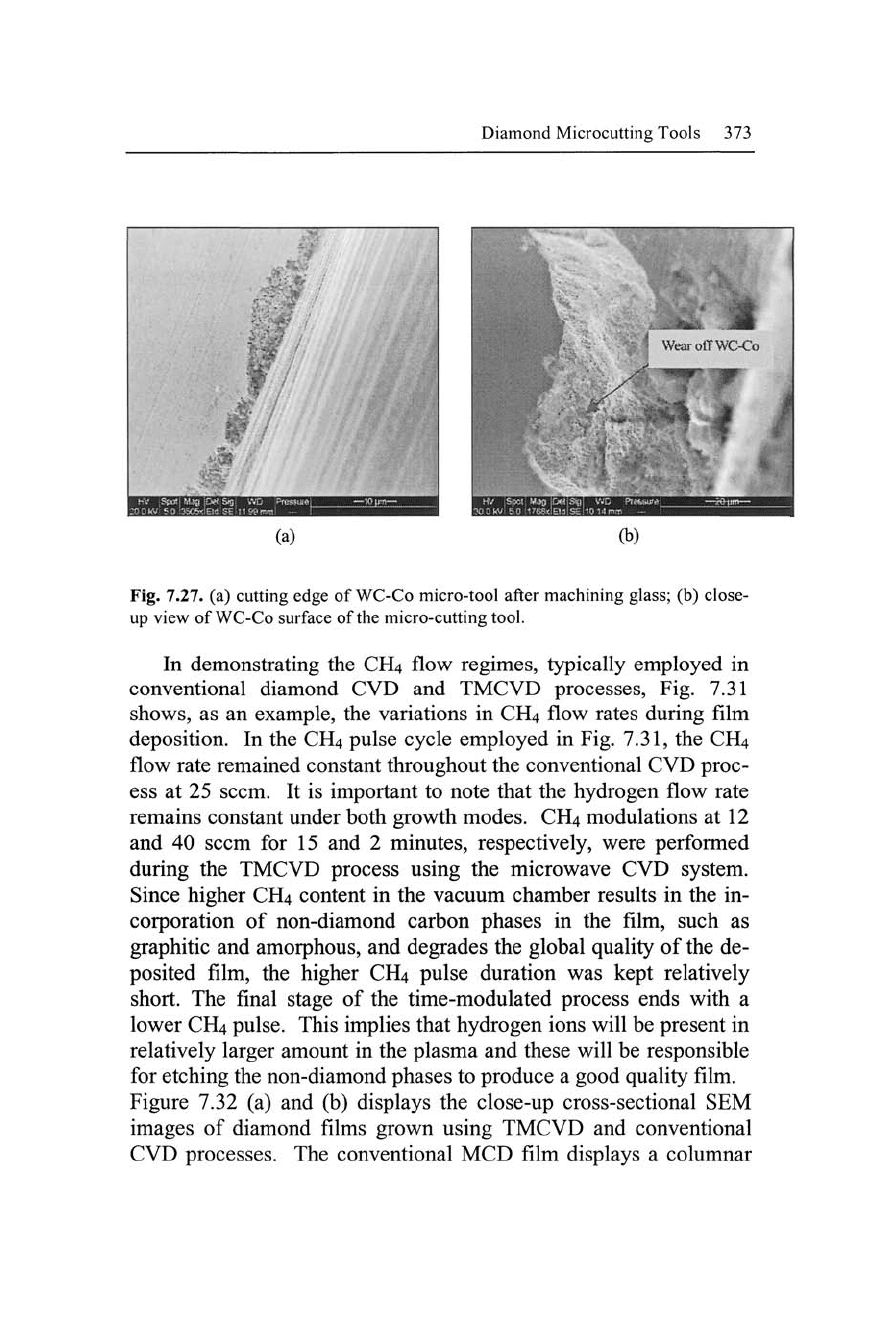
Diamond Microcutting Tools 373
(a)
Fig. 7.27. (a) cutting edge of WC-Co micro-tool after machining glass; (b) close-
up view of WC-Co surface of the micro-cutting tool.
In demonstrating the CH4 flow regimes, typically employed in
conventional diamond CVD and TMCVD processes, Fig. 7.31
shows, as an example, the variations in CH4 flow rates during film
deposition. In the CH4 pulse cycle employed in Fig. 7.31, the CH4
flow rate remained constant throughout the conventional CVD proc-
ess at 25 seem. It is important to note that the hydrogen flow rate
remains constant under both growth modes. CH4 modulations at 12
and 40 seem for 15 and 2 minutes, respectively, were performed
during the TMCVD process using the microwave CVD system.
Since higher CH4 content in the vacuum chamber results in the in-
corporation of non-diamond carbon phases in the film, such as
graphitic and amorphous, and degrades the global quality of the de-
posited film, the higher CH4 pulse duration was kept relatively
short. The final stage of the time-modulated process ends with a
lower CH4 pulse. This implies that hydrogen ions will be present in
relatively larger amount in the plasma and these will be responsible
for etching the non-diamond phases to produce a good quality film.
Figure 7.32 (a) and (b) displays the close-up cross-sectional SEM
images of diamond films grown using TMCVD and conventional
CVD processes. The conventional MCD film displays a columnar
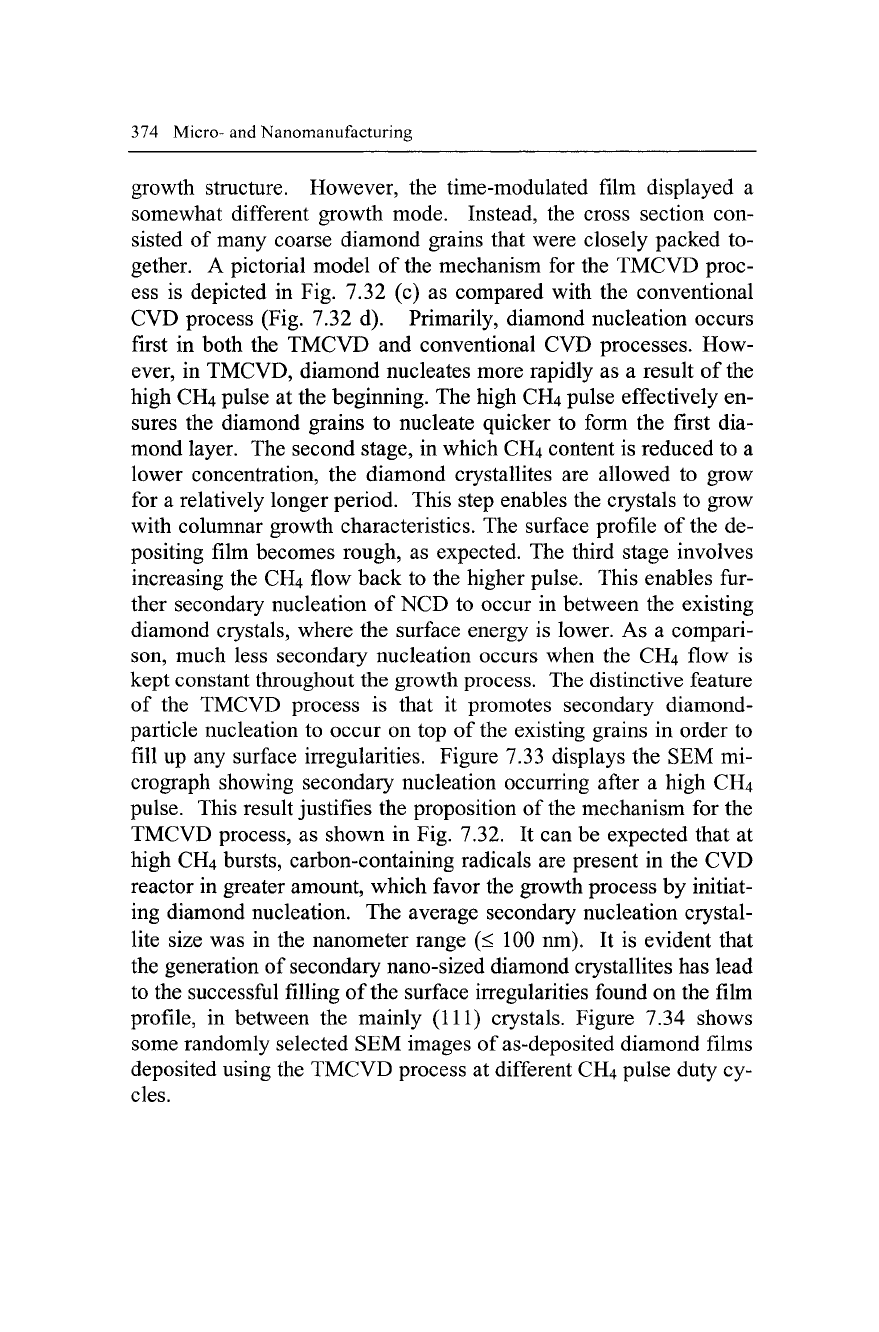
374 Micro- and Nanomanufacturing
growth structure. However, the time-modulated film displayed a
somewhat different growth mode. Instead, the cross section con-
sisted of many coarse diamond grains that were closely packed to-
gether. A pictorial model of the mechanism for the TMCVD proc-
ess is depicted in Fig. 7.32 (c) as compared with the conventional
CVD process (Fig. 7.32 d). Primarily, diamond nucleation occurs
first in both the TMCVD and conventional CVD processes. How-
ever, in TMCVD, diamond nucleates more rapidly as a result of the
high CH4 pulse at the beginning. The high CH4 pulse effectively en-
sures the diamond grains to nucleate quicker to form the first dia-
mond layer. The second stage, in which CH4 content is reduced to a
lower concentration, the diamond crystallites are allowed to grow
for a relatively longer period. This step enables the crystals to grow
with columnar growth characteristics. The surface profile of the de-
positing film becomes rough, as expected. The third stage involves
increasing the CH4 flow back to the higher pulse. This enables fur-
ther secondary nucleation of NCD to occur in between the existing
diamond crystals, where the surface energy is lower. As a compari-
son, much less secondary nucleation occurs when the CH4 flow is
kept constant throughout the growth process. The distinctive feature
of the TMCVD process is that it promotes secondary diamond-
particle nucleation to occur on top of the existing grains in order to
fill up any surface irregularities. Figure 7.33 displays the SEM mi-
crograph showing secondary nucleation occurring after a high CH4
pulse. This result justifies the proposition of the mechanism for the
TMCVD process, as shown in Fig. 7.32. It can be expected that at
high CH4 bursts, carbon-containing radicals are present in the CVD
reactor in greater amount, which favor the growth process by initiat-
ing diamond nucleation. The average secondary nucleation crystal-
lite size was in the nanometer range (< 100 nm). It is evident that
the generation of secondary nano-sized diamond crystallites has lead
to the successful filling of the surface irregularities found on the film
profile, in between the mainly (111) crystals. Figure 7.34 shows
some randomly selected SEM images of as-deposited diamond films
deposited using the TMCVD process at different CH4 pulse duty cy-
cles.
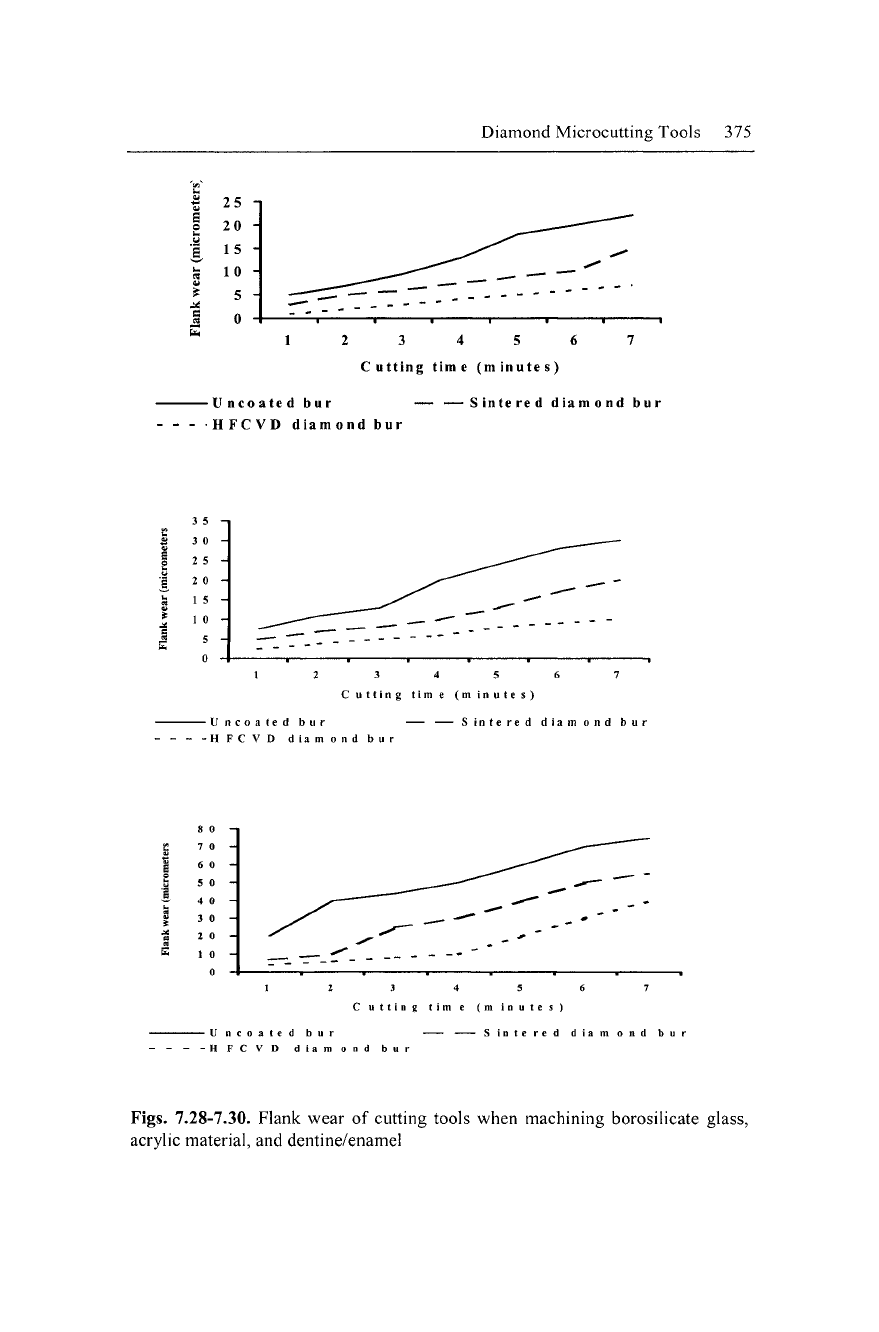
Diamond Microcutting Tools 375
^
^
25 1
20 A
15 H
10 A
5 A
2 3 4 5 6
Cutting time (minutes)
-U nco ate d bur
•H FC VD diamond bur
— —Sintered diamond bur
3 5
3 0
2 5
2 0
1 5
1 0
5
0
—
u
-H
ncoated bur
FCVD diamond bur
2 3 4 5 6 7
Cutting time (minutes)
Sintered diamond bur
8 0
7 0
6 0
5 0
4 0
3 0
2 0
1 0
Cutting time (minutes)
•U ncoated bur
•HFCVD diamond bur
Sintered diamond bur
Figs.
7.28-7.30. Flank wear of cutting tools when machining borosilicate glass,
acrylic material, an<i dentine/enamel
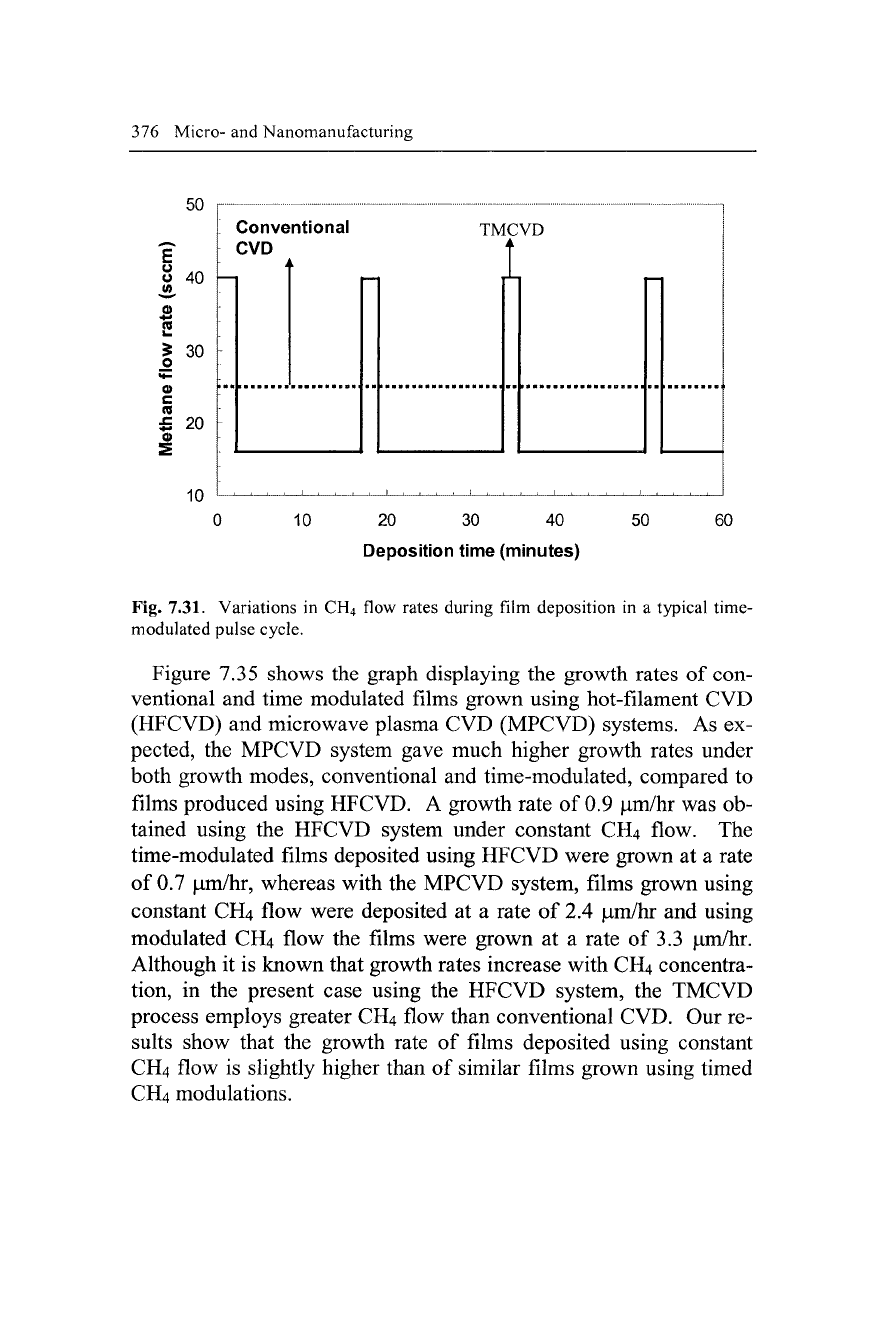
376 Micro- and Nanomanufacturing
50
E
o 40
30
o
c
CO
£ 20
10
Conventional
CVD
TMCVD
1
10 20 30 40
Deposition time (minutes)
50 60
Fig. 7.31. Variations in CH4 flow rates during film deposition in a typical time-
modulated pulse cycle.
Figure 7.35 shows the graph displaying the growth rates of con-
ventional and time modulated films grown using hot-filament CVD
(HFCVD) and microwave plasma CVD (MPCVD) systems. As ex-
pected, the MPCVD system gave much higher growth rates under
both growth modes, conventional and time-modulated, compared to
films produced using HFCVD. A growth rate of 0.9 \im/hr was ob-
tained using the HFCVD system under constant CH4 flow. The
time-modulated films deposited using HFCVD were grown at a rate
of 0.7 jLim/hr, whereas with the MPCVD system, films grown using
constant CH4 flow were deposited at a rate of 2.4 |Lim/hr and using
modulated CH4 flow the films were grown at a rate of 3.3 |Lim/hr.
Although it is known that growth rates increase with CH4 concentra-
tion, in the present case using the HFCVD system, the TMCVD
process employs greater CH4 flow than conventional CVD. Our re-
sults show that the growth rate of films deposited using constant
CH4 flow is slightly higher than of similar films grown using timed
CH4 modulations.
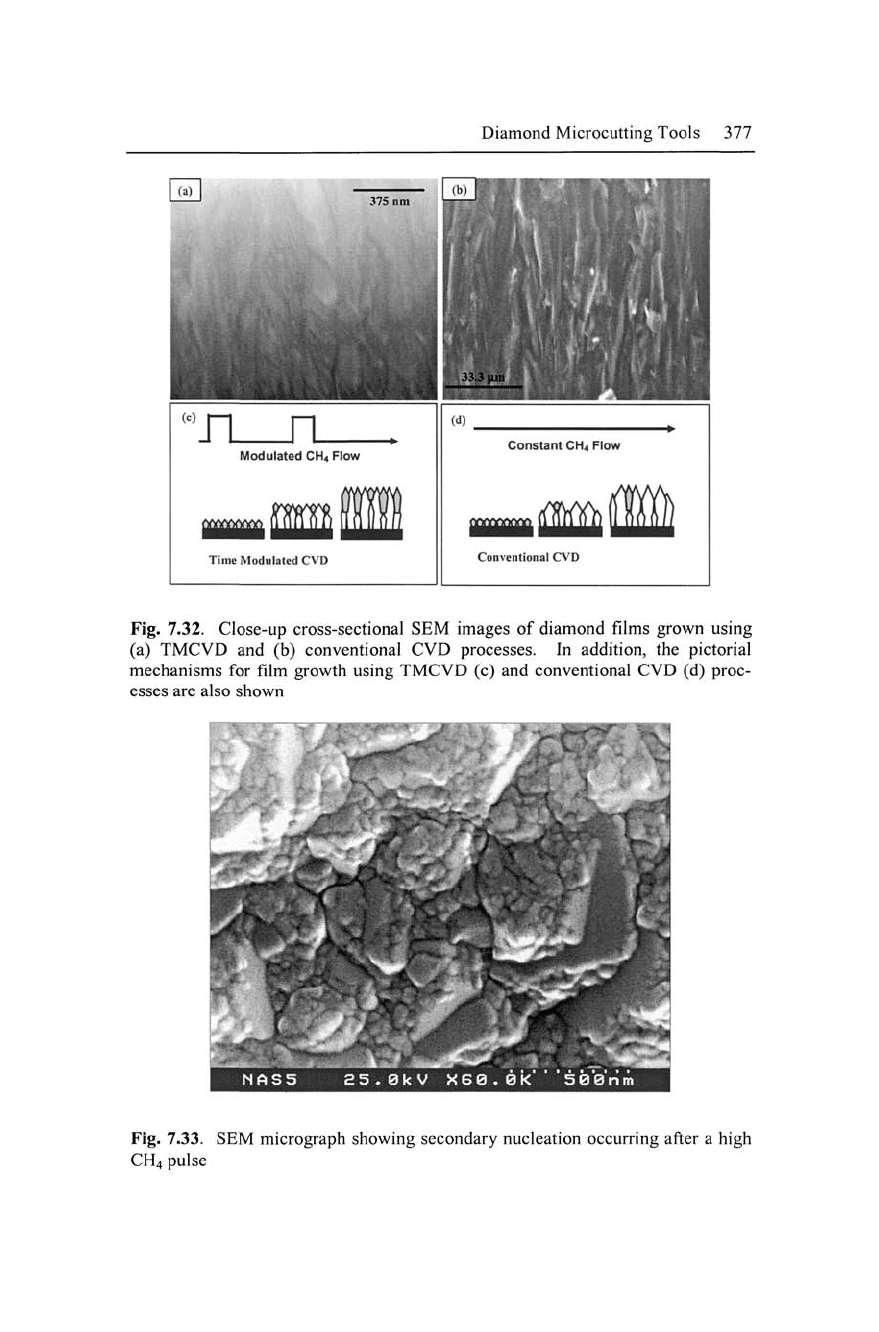
Diamond Microcutting Tools 377
H
'•'n
n
Modulated CH4 Flow
mn
Time Modulated CVD
(d)
Constant CH4 Flow
f(mh
Conventional CVD
Fig. 7.32. Close-up cross-sectional SEM images of diamond films grown using
(a) TMCVD and (b) conventional CVD processes. In addition, the pictorial
mechanisms for film growth using TMCVD (c) and conventional CVD (d) proc-
esses are also shown
Fig. 7.33. SEM micrograph showing secondary nucleation occurring after a high
CH4 pulse
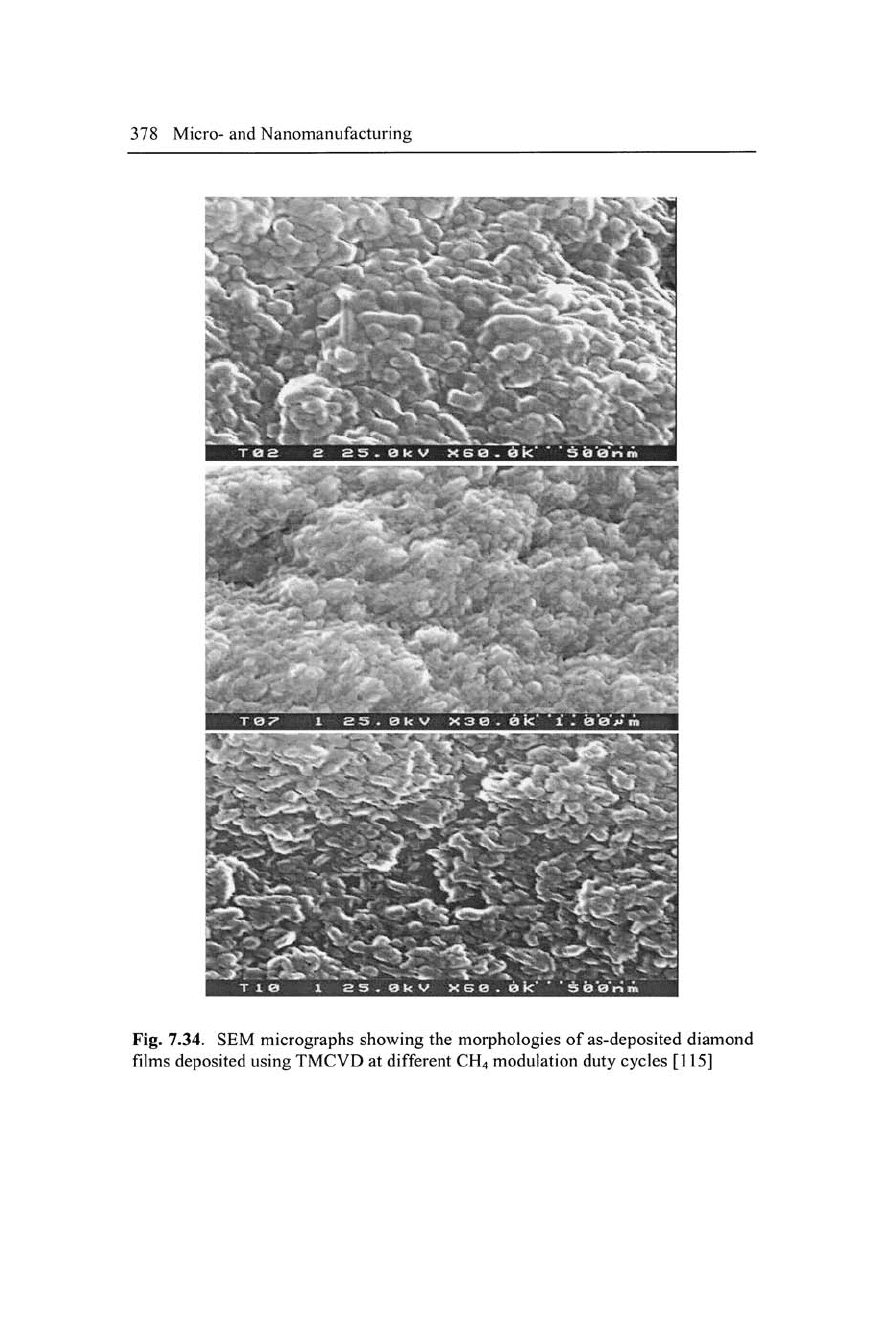
378 Micro- and Nanomanufacturing
Fig. 7.34. SEM micrographs showing the morphologies of as-deposited diamond
films deposited using TMCVD at different CH4 modulation duty cycles [115]
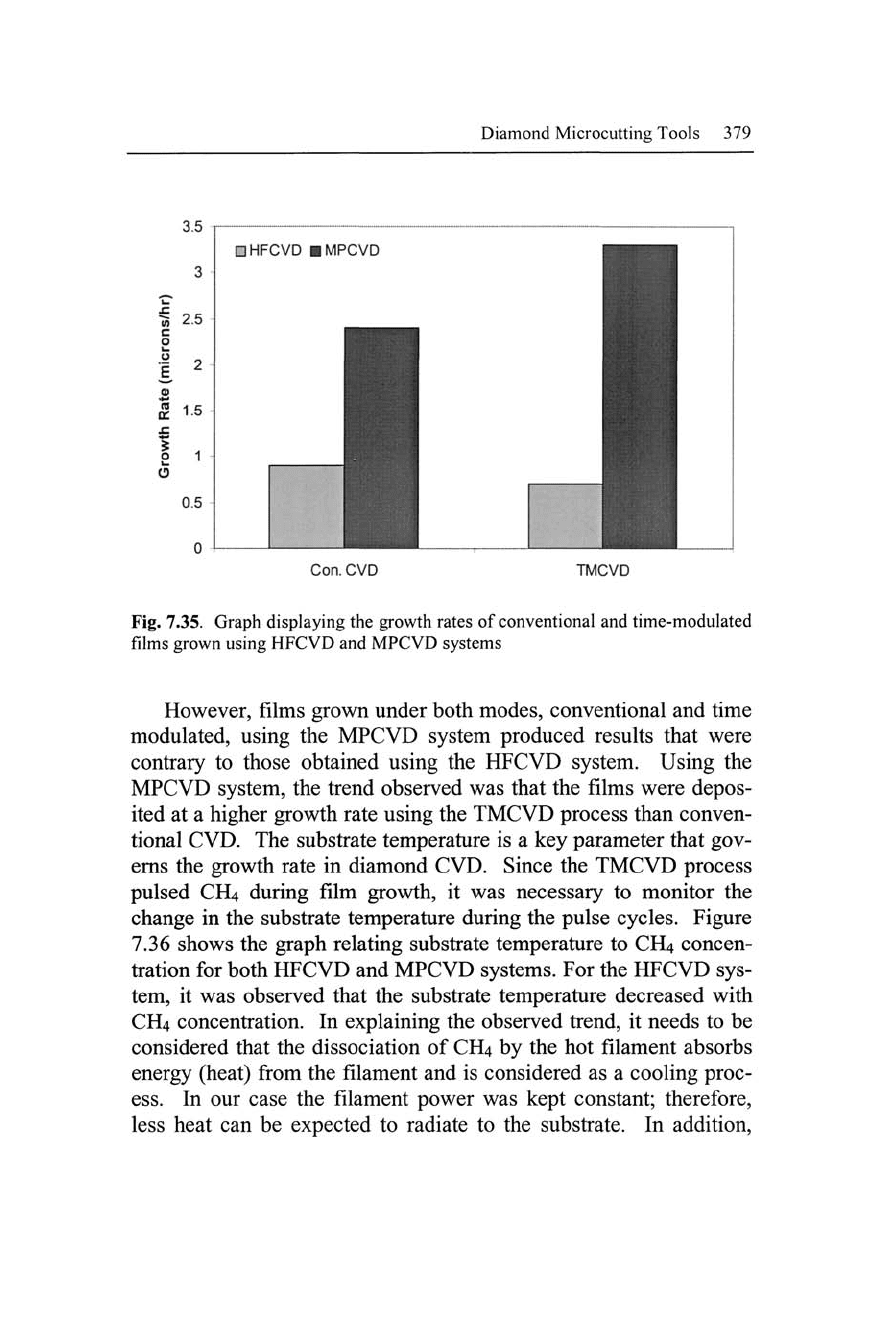
Diamond Microcutting Tools 379
Con.
CVD TMCVD
Fig. 7.35. Graph displaying the growth rates of conventional and time-modulated
films grown using HFCVD and MPCVD systems
However, films grown under both modes, conventional and time
modulated, using the MPCVD system produced results that were
contrary to those obtained using the HFCVD system. Using the
MPCVD system, the trend observed was that the films were depos-
ited at a higher growth rate using the TMCVD process than conven-
tional CVD. The substrate temperature is a key parameter that gov-
erns the growth rate in diamond CVD. Since the TMCVD process
pulsed CH4 during film growth, it was necessary to monitor the
change in the substrate temperature during the pulse cycles. Figure
7.36 shows the graph relating substrate temperature to CH4 concen-
tration for both HFCVD and MPCVD systems. For the HFCVD sys-
tem, it was observed that the substrate temperature decreased with
CH4 concentration. In explaining the observed trend, it needs to be
considered that the dissociation of CH4 by the hot filament absorbs
energy (heat) from the filament and is considered as a cooling proc-
ess.
In our case the filament power was kept constant; therefore,
less heat can be expected to radiate to the substrate. In addition,
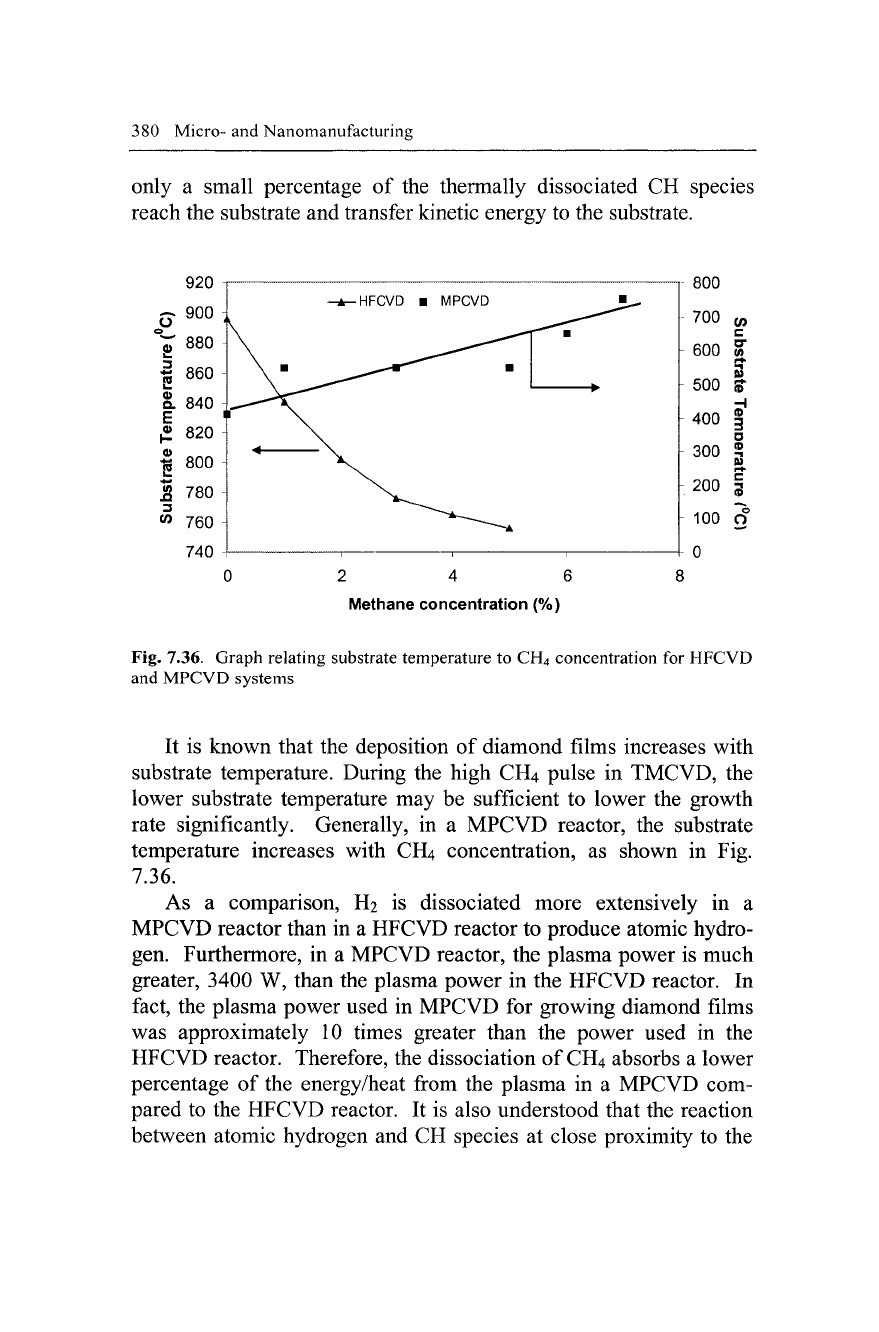
380 Micro-and Nanomanufacturing
only a small percentage of the thermally dissociated CH species
reach the substrate and transfer kinetic energy to the substrate.
\ \
M-
\
m
^^HFCVD • MPCVD
^ •
^
•^ •
-•
• ,
800
700
U)
920
jy 900
"^ 880
I 860
S. 840
E
,2 820
I 800
i 780
W 760
740
0 2 4 6 8
Methane concentration (%)
Fig. 7.36. Graph relating substrate temperature to CH4 concentration for HFCVD
and MPCVD systems
600
500
400
300
200
100
0)
!-•
3
J?
:;:*
0
3
0
(D
3
i-K
c
-^
0
It is known that the deposition of diamond films increases with
substrate temperature. During the high CH4 pulse in TMCVD, the
lower substrate temperature may be sufficient to lower the growth
rate significantly. Generally, in a MPCVD reactor, the substrate
temperature increases with CH4 concentration, as shown in Fig.
7.36.
As a comparison, H2 is dissociated more extensively in a
MPCVD reactor than in a HFCVD reactor to produce atomic hydro-
gen. Furthermore, in a MPCVD reactor, the plasma power is much
greater, 3400 W, than the plasma power in the HFCVD reactor. In
fact, the plasma power used in MPCVD for growing diamond films
was approximately 10 times greater than the power used in the
HFCVD reactor. Therefore, the dissociation of
CH4
absorbs a lower
percentage of the energy/heat from the plasma in a MPCVD com-
pared to the HFCVD reactor. It is also understood that the reaction
between atomic hydrogen and CH species at close proximity to the
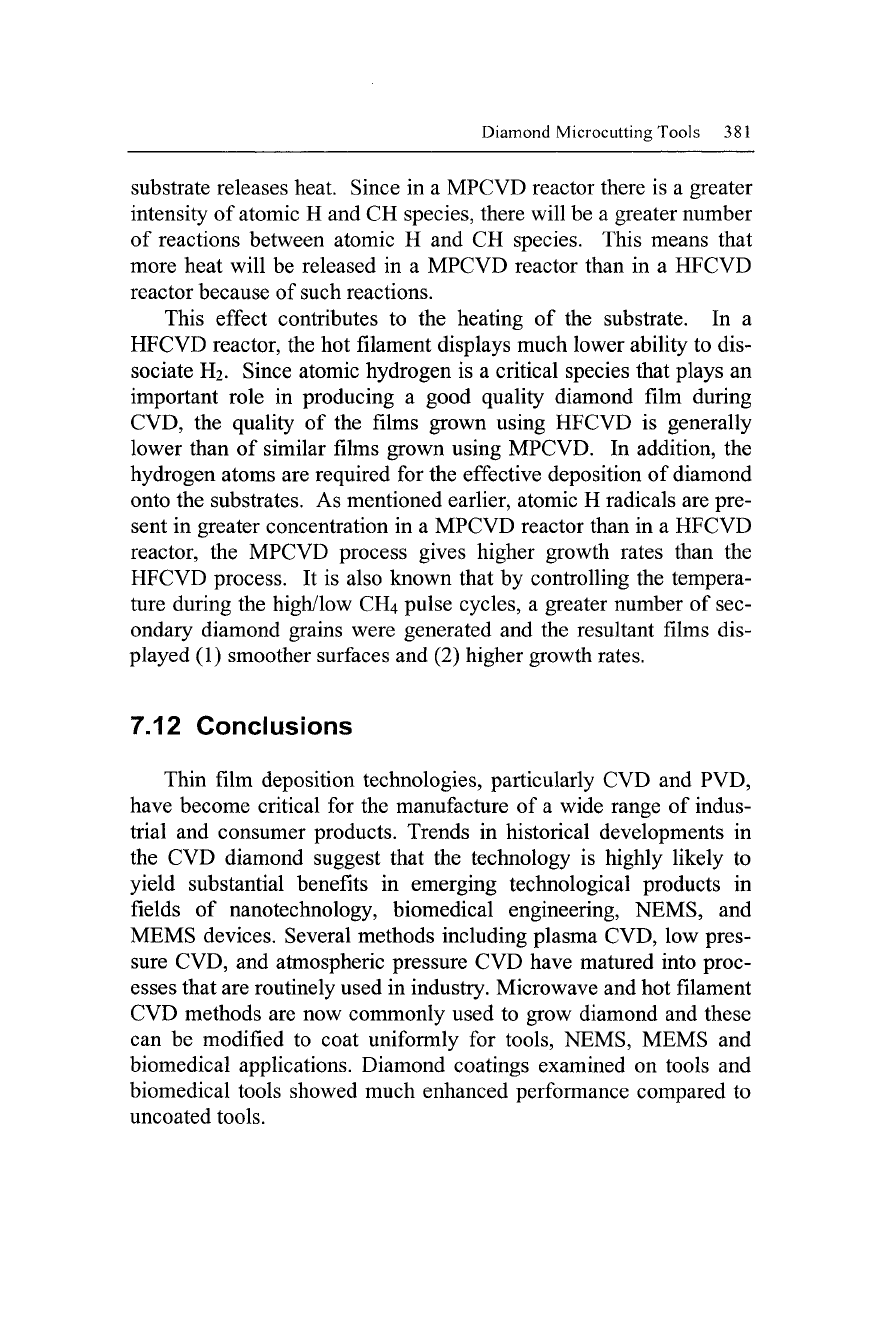
Diamond Microcutting Tools 381
substrate releases heat. Since in a MPCVD reactor there is a greater
intensity of atomic H and CH species, there will be a greater number
of reactions between atomic H and CH species. This means that
more heat will be released in a MPCVD reactor than in a HFCVD
reactor because of such reactions.
This effect contributes to the heating of the substrate. In a
HFCVD reactor, the hot filament displays much lower ability to dis-
sociate H2. Since atomic hydrogen is a critical species that plays an
important role in producing a good quality diamond film during
CVD,
the quality of the films grown using HFCVD is generally
lower than of similar films grown using MPCVD. In addition, the
hydrogen atoms are required for the effective deposition of diamond
onto the substrates. As mentioned earlier, atomic H radicals are pre-
sent in greater concentration in a MPCVD reactor than in a HFCVD
reactor, the MPCVD process gives higher growth rates than the
HFCVD process. It is also known that by controlling the tempera-
ture during the high/low CH4 pulse cycles, a greater number of sec-
ondary diamond grains were generated and the resultant films dis-
played (1) smoother surfaces and (2) higher growth rates.
7.12 Conclusions
Thin film deposition technologies, particularly CVD and PVD,
have become critical for the manufacture of a wide range of indus-
trial and consumer products. Trends in historical developments in
the CVD diamond suggest that the technology is highly likely to
yield substantial benefits in emerging technological products in
fields of nanotechnology, biomedical engineering, NEMS, and
MEMS devices. Several methods including plasma CVD, low pres-
sure CVD, and atmospheric pressure CVD have matured into proc-
esses that are routinely used in industry. Microwave and hot filament
CVD methods are now commonly used to grow diamond and these
can be modified to coat uniformly for tools, NEMS, MEMS and
biomedical applications. Diamond coatings examined on tools and
biomedical tools showed much enhanced performance compared to
uncoated tools.
